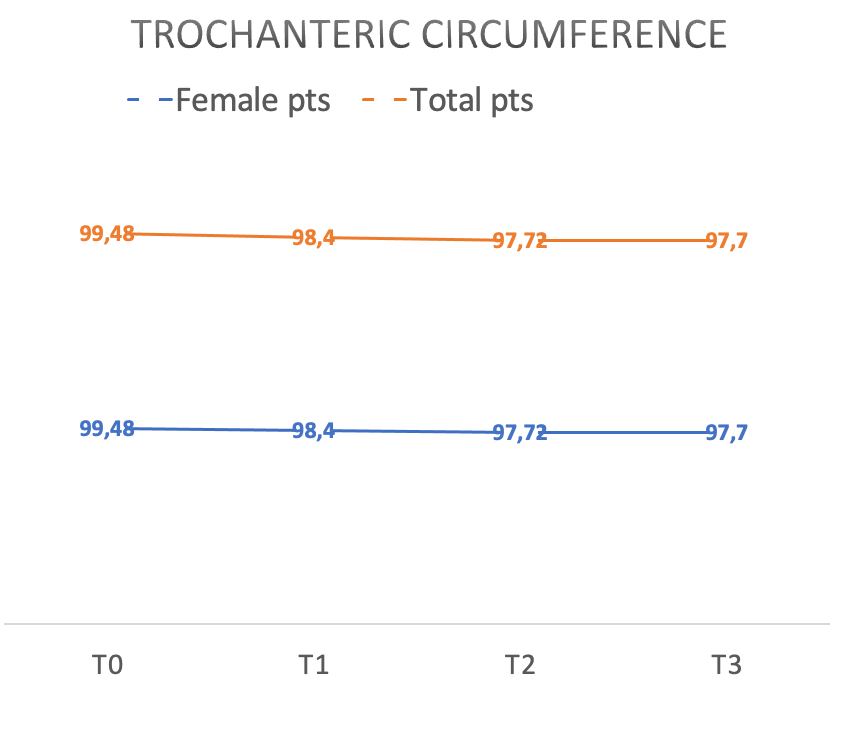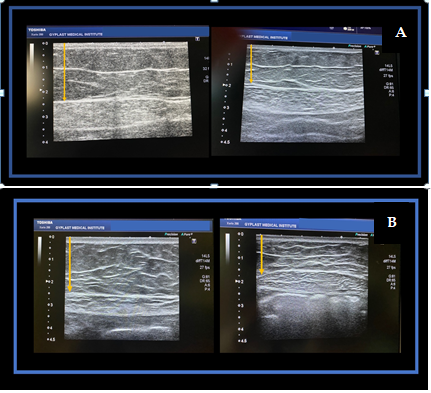Journal of
eISSN: 2574-9943


Research Article Volume 6 Issue 4
1Gyplast Medical Institute, Milano, Italy
2Vita-Salute San Raffaele university, Obstetrics and Gynecology department, Italy
Correspondence: Elena Fasola, Gyplast Medical Institute, Milano, Italy, Tel +39 3476441423
Received: November 30, 2022 | Published: December 15, 2022
Citation: Fasola E, Degliuomini RS. Non-invasive subcutaneous hyperthermic laser lipolysis with pulsed 1064nm diode laser for localized fat reduction. J Dermat Cosmetol. 2022;6(4):112-116. DOI: 10.15406/jdc.2022.06.00222
Non-invasive subcutaneous hyperthermic laser lipolysis could be an alternative to classic surgical liposuction. In this study the same physician treated 32 patients (22 females and 10 males) mainly in the abdomen and in the trochanteric region for 2 sessions, with specific and well-described settings. This treatment resulted to be extremely successful based on body weight, abdomen circumference, trochanteric circumference, abdomen subcutaneous fat ultrasound, trochanteric subcutaneous fat ultrasound. No adverse events were reported. Non-invasive subcutaneous hyperthermic laser lipolysis represents, therefore, a potential alternative to classic surgery in selected cases.
Keywords: fat reduction, laser lipolysis, non-invasive
Throughout the years, the demand for both men and women to achieve an aesthetically pleasant and shaped body has been growing. Specifically, the request of fat removal from some specific areas has seen an arousal to achieve a sort of “body contouring”. The gold standard remains the surgical liposuction which is the second most common plastic surgery in the USA (in 2018).1 However, non-surgical ways of body contouring are growing. The reasons behind this are mainly the lower side effect profile, reduced recovery time, patients’ adversity or non-eligibility for surgery.
Localized fat has a different distribution in men and women, and it is represented in different areas based on the constitutional type (gynoid or android phenotype). With age it is subjected to lipodystrophy phenomena. It is usually not edematous fibrosclerotic panniculopathy.
Non-invasive fat reduction is a fat reduction procedure done to decrease localized fat accumulated in specific body sites. Different methods have been demonstrated to be safe and effective and, also FDA approved.
Indeed, according to the Report ISAPS FEB/2021, non-surgical fat reduction was the fourth most performed non-invasive aesthetic procedure. Moreover, market predictions are even clearer. Non-invasive fat reduction has market size value in 2022 of USD 1.3 billion with a revenue forecast in 2030 of USD 4.3 billion.2
Among the possible non-surgical fat reduction techniques, laser lipolysis is one of the most common. However, all the settings of laser devices must be defined carefully to be safe and effective at the same time. It has been shown by numerous studies that the wavelength of 1064nm is particularly suitable for reaching adequate depths to be very active against adipose tissue. The wavelength of 1064nm achieved through diode technology allows refined control over the amount of heat delivered, at the appropriate depth, in the unit of time. The rationale behind is the following one. 1064 nm diode laser delivers an amount of energy/unit of time sufficient and necessary for a controlled temperature between 42 and 47° C reached directly in the adipose tissue, saving the dermis.3,4
The generated hyperthermia in the hypodermis induces the following photo-biological mechanisms. It increases the permeability of the adipocytes membrane and breaks down the triglycerides contained in them into free fatty acids and glycerol. These will subsequently be transported out of the cell and then metabolized by the cells as needed. Basically, laser treatment triggers an adipocyte apoptotic process and an inflammatory response in the adipose tissue within minutes of applying heat. The body's immune response clears cellular over the course of 6-12 weeks. The histologic effects of this thermal injury to the adipocytes after treatment on abdominal fat has also been observed in a previous study.5
Laser lipolysis is the only one, among the other non-invasive technique, to target a specific type of local fat accumulation. During perimenopause and menopause, indeed fat accumulation on women tents to change, becoming more similar to the male one. This fat is localized more in the trochanteric area and in the abdomen. This type of localized fat appears to have a more fibrotic structure and, probably for this reason, other non-invasive technologies don’t have any effect. On the other side laser-lipolysis appears to be effective. Perimenopausal and menopausal women, moreover, are more and more commonly asking for this type of “body contouring” treatment.6,7
This is a retrospective single-center study conducted by a single physician between September 2021 and June 2022. The recruited patients were 35 (12 males and 23 females).
The patients treated were 32 (22 females and 10 males) in age ranging from 25 to 59yo. Inclusion criteria were negative medical history, patients with localized fat in these regions: abdomen, suprapubic region, flank, trochanteric region, thigh, inner knee, arm. Patients also had mixed fat morphology (LF + PEFS) and good skin elasticity in the treated area. All patients were accurately informed about the methodology and signed a consent to participate to this study. After an accurate and long counselling, they were all aware of the expectations according to results obtainable from non-invasive treatments. If patients’ expectations were still similar to those of liposuction, they were not included. All patients treated, males and females, had similar lifestyle habits: high socio-economical status, active life practicing sports.
Men patients mainly demanded treatment of the abdominal region, none of them desired treatment of trochanteric region. Women, on the other hand, demanded treatment of both areas or only one of them.
Exclusion criteria were patients with some comorbidities, devices or intaking drugs (implanted pacemaker, epilepsy, myasthenia gravis, autoimmune soft tissue diseases, neurodegenerative diseases, photosensitizing drugs, ongoing oncological diseases and/or oncological therapies, anticoagulant therapies). Other exclusion criteria were: obese or ex-obese patients (BMI over 31), patients with skin laxity carefully evaluated to body areas and age, patients with cellulite and/or severe lipoedema.
The patients underwent the treatment every four weeks, for a total of two treatments.
Every treatment consisted in a laser session with a device laser class 4 (1064 nm Diode - APG Medical) using with the following characteristics:
The photobiological damage induced by Laser in a tissue is: directly dependent on the laser wavelength, its absorption coefficient, possible scattering, its absolute power, the power density delivered (W/cm2), time of exposure on the tissue and the handpieces/tips dimension.
The rationale of the choice of wavelength of 1064nm was explained beforehand.3 The 1064NM Diode laser delivers energy evenly across the entire surface of the handpiece in contact with the skin.
The choice of intermittent modality for the way of emission was for a specific reason: the peak power is always greater than the average power and the temperature increase in the target tissue is controllable. In this way, the so-called “thermal relaxation phenomenon” occurs in the period of non-emission.
The laser device was equipped with a cooling system: laser handpieces contacting skin are cooled through a Peltier cells system which generates a surface constant temperature of about 18°-20°. Many security systems were also linked to the device stopping immediately laser emission if not perfectly adhering to the skin.
Supports for the handpieces were applied, all previously mentioned programs were set, treatment was then started, lasting 30 minutes.
The investigated areas were abdomen, trochanteric region and hip in female patients, abdomen and hip in male patients. The investigative methodologies used were different:
All these analyses were carried out at three different time points:
Three patients (2 males and one female) decided to abandon the study for personal reasons (no side effects were reported) with a drop-out rate of 1, 16%
Patients had a median age of 46, 8 years.
As shown in Table 1 and the graphs (Figures 2-4), results appeared to be successful. The abdomen circumference appeared to be reduced of 2.25 cm in total patients (1.94 in female and 2.48 in male patients). The trochanteric circumference was reduced of 1.79 cm (as explained before all patients were women). The medium weight loss for all patients was 1.26 kg (1.1 kg in females and 2.73 in male patients). The medium loss expressed in centimeters demonstrated by ultrasound was of 0,56 cm in abdominal/hips area and 0,52 cm in trochanteric area for total number of patients (0,55 cm in females and 0,57 in males), in females the abdominal and trochanteric areas were investigated with ultrasound, in males only the abdominal area (Figure 5,6). Since this treatment is a may be defined a “body sculpting” the most important results are circumferences and adipose tissue reduction demonstrated by ultrasound and not weight loss which may be influenced by other factors (such as implementation of muscle mass). All results are also represented here in graphs. Also, iconography was acquired at the different timelines with patient in orthostatic position. All pictures were acquired with an I-Phone 12 Plus (Figure 7-14).

Figure 3 Abdomen/hips circumference loss in patients who underwent treatment. (Expressed in Centimeters).

Figure 4 Trochanteric circumference loss in patients who underwent treatment. (Expressed in Centimeters).

Figure 6 Ultrasound of abdominal area 56 years-old male patient, T0, T3 (A) - Ultrasound of abdominal area 50 years-old female patient (B).
|
|
Weight loss (kg) |
Abdomen/hips circumference (cm) |
Trochanteric circumference (cm) |
Abdomen/hips ultrasound |
Trochanteric ultrasound |
|
Female pts |
1,1 |
1,94 |
1,79 |
0,55 |
0,52 |
|
Male pts |
2,73 |
2,48 |
- |
0,57 |
- |
|
Total pts |
1.26 |
2,25 |
1,79 |
0,56 |
0,52 |
Table 1 Results of treatment (number expressed in medium)
As clearly emerging from results, male patients had better amelioration from treatment. As well known in literature, the levels of FSH, LH and particularly of E2 strongly influence distribution and constitution of fat in post-menopausal women. Menopause or perimenopause interested women who were undergoing the treatment. On the other hand, the so-called andropause involves men around 70 years old. This means that lo localized fat treated in women has components which are more difficult to treat, compared to the type of fat present in men, due to hormonal reasons.7 The treatment resulted to be very well tolerated. Patients only referred very localized hot/cold sensation), slight skin redness (often not present) and slight stamping effect on the skin in treated area due to the pressure on the skin of handpieces supports.
In selected cases, non-invasive subcutaneous hyperthermic laser lipolysis demonstrated to be a valid alternative to surgery, from this study. The settings and methods previously described appear to reach success without causing discomfort or damage, being therefore for now considerable optimal. The slight difference in results between men and women, in abdominal area, given its hormonal cause, may require further investigation, also to approach abdominal fat in females in different way, for example with an extra session or by setting the laser with different parameters compared with the same procedure for male patients. Future studies may also focus on increasing the number of patients involved, also considering patients of different racial backgrounds.
Non-invasive subcutaneous hyperthermic laser lipolysis is safe and effective and is valid alternative to surgical liposuction, in carefully selected cases. This out-patient treatment allows the patient to have the demanded “body-contouring” in a shorter time, a less invasive manner and, also, a less psychologically demanding way.
None.
Authors declare there is no conflict of interest.

©2022 Fasola, et al. This is an open access article distributed under the terms of the, which permits unrestricted use, distribution, and build upon your work non-commercially.